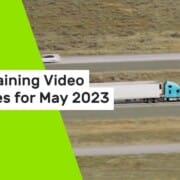8 Ways to Cut Transportation Costs
1. Audit yourself.
Don’t wait for an audit—do it yourself. Not just a DOT audit, but a regular business audit. Regular audits give you an accurate lay of the land and set standards and structures for going forward. Where is your money going, and why? These questions can only be answered with a complete audit. Just hold your breath and dive in.
First step: get all your budgets and records on target. Clean house, leaving no receipt, timecard, or invoice unturned. Improve record keeping where necessary, and review all budgets for clarity, discrepancies, and whether they’re matching your goals. Follow the Golden Rule for record keeping… “If it’s not in writing, If it’s not signed, if it’s not dated or you can’t find it, it didn’t happen.”
Here is a free FMCSA Safety Resource Guide to help with that audit.
2. Track profit and loss, monthly
Create monthly profit and loss statements. Yearly statements are important, too. But if you wait and do this only once a year, it is too late to make the changes and celebrate the victories that keep you on target month-to-month. It’s easier to make incremental small changes than to implement large ones.
3. Find redundancies
It is also easier to save money in-house than to generate more revenue. Before you start pushing your drivers harder or streamlining operations. Ask:
- Is the company duplicating any materials or efforts? Where?
- Where do we see inefficiencies in the workflow?
- Can we outsource tasks, such as marketing or HR?
- Do we need to cancel third parties that aren’t bringing in revenue?
4. Train dispatchers
Dispatchers can save you money. By guiding goals and routes, they are de facto business managers. Your main question here is, are they incentivizing efficiency among drivers? Many dispatchers tend to create goals and manage in such a way that maximizes raw mileage. Your drivers deserve their due, but efficiency is also key.
Train dispatchers in a management style that doesn’t cause driver turnover. And make it worth their while. Find ways to increase efficiency through goals, routes, and driver communication, and offer managers and dispatchers a cut of the savings.
5. Hire well
Good hiring and training are a gateway to savings.
Get drivers on the road as safely and as soon as possible. This means you may need to update. Onboarding that’s streamlined and branded keeps you organized, makes drivers happy, and makes them proud to work for your company. Long, repetitive safety meetings and orientations under fluorescent lights may tick a box for you, but that doesn’t mean drivers were engaged, retaining, or getting what they need.
Provide online learning whenever possible, keep training interesting, short and frequent. Training efficiency saves money and gets drivers on the job more quickly.
When hiring office employees, shoot for a trim team and efficient operations. Your goal is to have no more than one non-driver per five trucks. Office costs and overlapping efforts can be greatly reduced when a team is hired and trained effectively.
6. Embrace maintenance
Being prepared and staying ahead on vehicle maintenance is one of the best ways to stay safe and save money. Keep regular procedures in place for initiating and tracking maintenance. Make sure access and storage of updated and complete tractor and trailer maintenance records are maintained at all times. Finally, keep on top of maintenance training, as it’s one of your #1 ways to reduce incidents on the road.
This proverbial ounce of prevention is worth a pound of cure in greater repair costs, accidents, malfunction, roadside assistance, and litigation. You keep costs down by maximizing fuel efficiency, and your drivers feel safe, cared for, and proud of their vehicles. This can be a huge factor in attracting new drivers.
7. Care for employees
To cut costs successfully, you need the genuine trust of your team. Trust reduces “intangible costs” caused by stress, illness, negative emotions, and the like. Employee loyalty and buy-in are invaluable. When it comes to budget cuts, a good culture of communication includes:
- Giving employees a heads up on changes in advance
- Explaining how company news affects them
- Providing access to leadership
- Staying available for dialogue, questions, and feedback
- Keeping them updated on policy changes, company cascading messaging, and employee news.
A great way to organize and distribute this information is electronically.
If you haven’t done these things, there’s no better time than now. Changes don’t hit so hard when there is open, trusting communication between you and your team.
8. Be open to change
Budget changes may be non-negotiable, but the policies that put them into practice are not. With a company built on the good work of your people, caring for them is your top priority, and your loyalty to them needs to be one of your main considerations. You’re in the people business first; then you are in the transportation business. When you operate that way, with transparency, drivers know it. Happy, committed drivers are safe, invested drivers. Your willingness to listen and change means longevity, and a healthy, inviting professional atmosphere.
Infiniti Workforce Solutions provides cost-saving, state-of-the-art training programs for the transportation sector, using a proven microlearning model. Put your best drivers on the road. Keep them for the long haul. Request a free demo of Infiniti today.
We hope you learned from out tips on ways to cut transportation costs.











